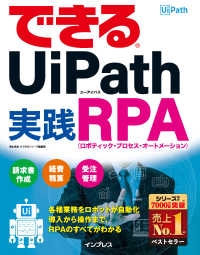Full Description
Through this book, we seek to describe improvement science in action for educators, schools, districts, universities, and communities. This book is a venue for improvement research in education focused on the application of improvement science in educational settings. Improvement science requires extensive engagement in rigorous work to implement sustainable change at a systemic level. As the editors of this volume for the Leadership in School Improvement SIG book series, we hope that these chapters, written by researchers, practitioners, and leaders engaged in improvement science will help others begin their own improvement processes to achieve desired, equitable, and sustainable results for student success.
Contents
Foreword: A Field Is Building; Anthony S. Bryk.
Introduction.
Section I: Stories Of Improvement.
Chapter 1. Towards Synergistic Critical Race Improvement Science; Kris DeFilippis.
Chapter 2. Joyful, Powerful Mathematics for All: Schoolwide Lesson Study to Support Teaching Through Problem-solving; Catherine Lewis, Shelley Friedkin, Nora Houseman, Sara Liebert, Norma Ming, and Akihiko Takahashi.
Chapter 3. Continuous Improvement in STEM Education: Collaboration Among Four Partners to Co-Design an Innovative and Equitable STEM School; Jeanna R. Wieselmann, Annie Wright, and Stephanie Knight.
Chapter 4. Leveraging Collaborative Teacher Leadership for Equitable School Transformation; Wesley Henry and Adam Swinney.
Chapter 5. Building Leadership Capacity for School-Based Reform in the Arab Region: The TAMAM model; Rima Karami, Yusra Khattab, and Rola Katerji.
Chapter 6. Building Capacity to Lead Instructional Improvement in a Title I Middle School; Rebecca A. Thessin and Briana Bostic.
Section II: Enabling Conditions For Improvement.
Chapter 7. ImproveCrit: Using Critical Race Theory to Guide Continuous Improvement; Brandi Hinnant-Crawford, Ericka Lytle Lett, and Shamella Cromartie.
Chapter 8. Building Capacity for Continuous Improvement: Iterating to Center Racial Equity in a PK-8 Community School; Anne Garrison Wilhelm, Dana Stoltz Gray, and Erin O. Crosby.
Chapter 9. Sustaining Continuous School Improvement: A Framework for Transformative Organizations; Erin Anderson, Kathleen M. W. Cunningham, and Jayson W. Richardson.
Chapter 10. Attending to Role Identities Within Continuous Improvement; Alison Fox Resnick.
Chapter 11. Developing Enabling Conditions for Continuous Improvement: Building Foundational Team Habits of Mind; Elizabeth Zumpe and Corrine Aramburo.
Chapter 12. How Coaches Support Improvement Teams: Challenges and Considerations; Edit Khachatryan, Barbara Shreve, and Jonathan Eckert.
Chapter 13. Assessing Leadership Skills and Organizational Conditions for Continuous Improvement: Two Approaches; Chad R. Lochmiller and Margaret Terry Orr.
Chapter 14. Integrating Improvement Science Into Leadership Preparation Programs: Enduring Challenges and Promising Strategies; Maxwell M. Yurkofsky, Edwin N. Bonney, and Sarah A. Capello.
Section III: Partnering For Improvement.
Chapter 15. The National Education Association Community Schools Institute: Developing Cultures of Equity and Innovation in Public Schools Across the United States; Linda Mayger and Kathleen Provinzano.
Chapter 16. Ensuring Success for Research-Practice Partnerships: Strategies and Conditions; Linda Bendikson and Frauke Meyer.
Chapter 17. How Research-Practice Partnerships Learn to Develop Goals for Math and Identify Local Problems of Practice; Benjamin Michael Superfine, Craig De Voto, Alison Castro Superfine, Shelby Cosner, and Ahreum Han.
Chapter 18. Constructing a Good Fit: Improvement Team Leads' Perspectives on Fitting Improvement Work to Their Sites; H. Alix Gallagher, Leah Faw, Danielle Jordan, Kiley O'Meara, and Benjamin Cottingham.
Chapter 19. From Initiation to Dissolution: Learning from the Unsuccessful Launch of Networked Improvement; Jennifer Karnopp and Chad Lochmiller.
Chapter 20. A Tale of Two University-School Improvement Hubs: An Ecological View of Hub and Hub Leader Development; Sarah Zuckerman and Kristen Campbell Wilcox.
Chapter 21. Exploring the Boundary Space in Partnerships for Continuous Improvement and Leadership; Manuelito Biag, Louis M. Gomez, and David G. Imig.
Chapter 22. Designing the EdD for Transformative Change; Margaret Terry Orr and Elizabeth Leisy Stosich.
About the Contributors.
-

- 電子書籍
- 愛さないといわれましても ~元魔王の伯…
-

- 電子書籍
- 税理士 24 酒税法 計算問題+過去問…
-

- 電子書籍
- 会社をやめて馬主やります! ― アキコ…
-

- 電子書籍
- できるUiPath 実践RPA
-

- 電子書籍
- ギブミー睡眠 リトルモンスター・ひなと…



